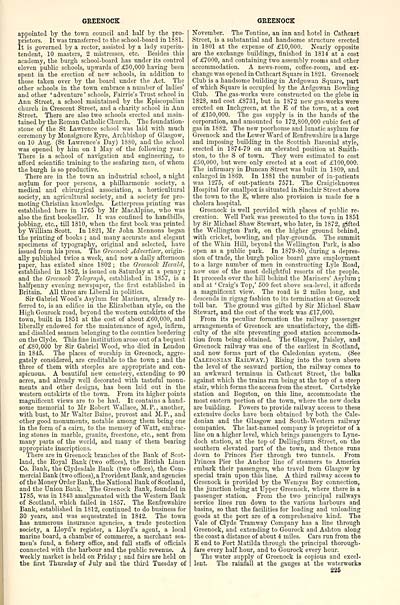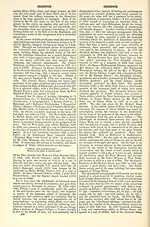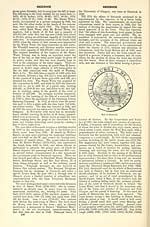Ordnance gazetteer of Scotland > Volume 3
(295) Page 225
Download files
Complete book:
Individual page:
Thumbnail gallery: Grid view | List view

GREENOCK
appointed by the town council and half by the pro-
prietors. It was transferred to the school-board in 1881.
It is governed by a rector, assisted by a lady superin-
tendent, 10 masters, 2 mistresses, etc. Besides this
academy, the burgh school-board has under its control
eleven public schools, upwards of £50,000 having been
spent in the erection of new schools, in addition to
those taken over by the board under the Act. The
other schools in the town embrace a number of ladies'
and other ' adventure ' schools, Fairrie's Trust school in
Ann Street, a school maintained by the Episcopalian
church in Crescent Street, and a charity school in Ann
Street. There are also two schools erected and main-
tained by the Roman Catholic Church. The foundation-
stone of the St Lawrence school was laid with much
ceremony by Monsignore Eyre, Archbishop of Glasgow,
on 10 Aug. (St Lawrence's Day) ISSO, and the school
was opened by him on 1 May of the following year.
There is a school of navigation and engineering, to
afford scientific training to the seafaring men, of whom
the burgh is so productive.
There are in the town an industrial school, a night
asylum for poor persons, a philharmonic society, a
medical and chirurgical association, a horticultural
society, an agricultural society, and a society for pro-
moting Christian knowledge. Letterpress printing was
established here in 1765 by Mr MacAlpine, who was
also the iii'st bookseller. It was confined to handbills,
jobbing, etc., till 1810, when the fu'st book was printed
by William Scott. In 1821, Mr John Mennons began
the printing of books ; and many accurate and elegant
specimens of typography, original and selected, have
issued from his press. The Greenock Advertiser, origin-
ally published twice a week, and now a daily afternoon
paper, has existed since 1802 ; the Greenock Herald,
established in 1852, is issued on Saturday at a penny ;
and the Greenock Telegraph, established in 1857, is a
halfpenny evening newspaper, the first established in
Britain. All three are Liberal in polities.
Sir Gabriel AYood's Asylum for iilariners, already re-
ferred to, is an edifice in the Elizabethan style, on the
High Gourock road, bej"ond the western outskirts of the
town, built in 1851 at the cost of about £60,000, and
liberally endowed for the maintenance of aged, infirm,
and disabled seamen belonging to the counties bordering
on the Clyde. This fine institution arose out of a bec[uest
of £80,000 by Sir Gabriel Wood, who died in London
in 1845. The places of worship in Greenock, aggre-
gately con.sidered, are creditable to the town ; and the
three of them with steeples are appropriate and con-
spicuous. A beautiful new cemetery, extending to 90
acres, and already well decorated with tasteful monu-
ments and other designs, has been laid out in the
western outskirts of the town. From its higher points
magnificent views are to be had. It contains a hand-
some memorial to Mr Robert Wallace, M. P. , another,
■with bust, to Mr Walter Baine, provost and M.P., and
other good monuments, notable among them being one
in the form of a cairn, to the memory of Watt, embrac-
ing stones in marble, granite, freestone, etc., sent from
many parts of the world, and many of them bearing
appropriate inscriptions.
There are in Greenock branches of the Bank of Scot-
land, the Royal Bank (two ofiices), the British Linen
Co. Bank, the Clydesdale Bank (two offices), the Com-
mercial Bank (two offices), a Provident Bank, and agencies
of the Money Order Bank, the National Bank of Scotland,
and the Union Bank. The Greenock Bank, founded in
1785, was in 1843 amalgamated with the Western Bank
of Scotland, which failed in 1857. The Renfrewshire
Bank, established in 1812, continued to do business for
30 years, and was sequestrated in 1842. The town
has numerous insurance agencies, a trade protection
society, a Lloyd's register, a Lloyd's agent, a local
marine board, a chamber of commerce, a merchant sea-
men's fund, a fishery office, and full staffs of officials
connected with the harbour and the public revenue. A
weekly market is held on Friday ; and fairs are held on
the first Thursday of July and the third Tuesday of
GREENOCK
November. The Tontine, an inn and hotel in Cathcart
Street, is a substantial and handsome structure erected
in 1801 at the expense of £10,000. Nearly opposite
are the exchange buildings, finished in 1814 at a cost
of £7000, and containing two assembly rooms and other
accommodation. A news-room, coffee-room, and ex-
change was opened in Cathcart Square in 1821. Greenock
Club is a handsome building in Ardgowan Square, part
of which Square is occupied by the Ardgowan Bowling
Club. The gas-works were constructed on the glebe in
1828, and cost £8731, but in 1872 new gas-works were
erected on Inchgreen, at the E of the town, at a cost
of £150,000. The gas supply is in the hands of the
corporation, and amounted to 172,800,000 cubic feet of
gas in 1882. The new poorhouse and lunatic asylum for
Greenock and the Lower Ward of Renfrewshire is a large
and imposing building in the Scottish Baronial style,
erected in 1874-79 on an elevated position at Smith-
ston, to the S of to'svn. They were estimated to cost
£50,000, but were only erected at a cost of £100,000.
The infirmary in Duncan Street was built in 1809, and
enlarged in 1869. In 1881 the number of in-patients
was 1275, of out-patients 7571. The Craigieknowes
Hospital for smallpox is situated in Sinclair Street above
the town to the E, where also provision is made for a
cholera hospital.
Greenock is well provided with places of public re-
creation. Well Park was presented to the town in 1851
by Sir Michael Shaw Stewart, who later, in 1872, gifted
the Wellington Park, on the higher ground behind,
with cricket, bowling, and play-grounds. The summit
of the Whin Hill, beyond the AVellington Park, is also
open as a public park. In 1879-80, during a depres-
sion of trade, the burgh police board gave emplo3'ment
to a large number of men in constructing Lyle Road,
now one of the most delightful resorts of the people.
It proceeds over the hill behind the Mariners' Asylum ;
and at ' Craig's Top,' 500 feet above sea-level, it affords
a magnificent view. The road is 2 miles long, and
descends in zigzag fashion to its termination at Gourock
toll bar. The ground was gifted by Sir Michael Shaw
Stewart, and the cost of the work was £17,000.
From its peculiar formation the railway passenger
arrangements of Greenock are unsatisfactory, the diffi-
culty of the site preventing good station accommoda-
tion from being obtained. The Glasgow, Paisley, and
Greenock railway was one of the earliest in Scotland,
and now forms part of the Caledonian system. (See
Caledonian Railway.) Rising into the town above
the level of the seaward portion, the railway comes to
an awkward terminus in Cathcart Street, the balks
against which the trains run being at the top of a steep
stair, which forms the access from the street. Cartsdyke
station and Bogston, on this line, accommodate the
most eastern portion of the town, where the new docks
are building. Powers to provide railway access to these
extensive docks have been obtained by both the Cale-
donian and the Glasgow and South-Western railway
companies. The last-named company is proprietor of a
line on a higher level, which brings passengers to Lyne-
doch station, at the top of Dellingburn Street, on the
southern elevated part of the town, and thence runs
down to Princes Pier through two tunnels. From
Princes Pier the Anchor line of steamers to America
embark their passengers, who travel from Glasgow by
special train upon this line. A third railway access to
Greenock is provided by the Wemyss Bay connection,
the junction being at Upper Greenock, where there is a
passenger station. From the two principal railways
service lines run down to the various harbours and
basins, so that the facilities for loading and unloading
goods at the port are of a comprehensive kind. The
Vale of Clyde Tramway Company has a line through
Greenock, and extending to Gourock and Ashton along
the coast a distance of about 4 miles. Cars run from the
E end to Fort Matilda through the principal thorough-
fare every half hour, and to Gourock every hour.
The water supply of Greenock is copious and excel-
lent. The rainfall at the gauges at the waterworks
225
appointed by the town council and half by the pro-
prietors. It was transferred to the school-board in 1881.
It is governed by a rector, assisted by a lady superin-
tendent, 10 masters, 2 mistresses, etc. Besides this
academy, the burgh school-board has under its control
eleven public schools, upwards of £50,000 having been
spent in the erection of new schools, in addition to
those taken over by the board under the Act. The
other schools in the town embrace a number of ladies'
and other ' adventure ' schools, Fairrie's Trust school in
Ann Street, a school maintained by the Episcopalian
church in Crescent Street, and a charity school in Ann
Street. There are also two schools erected and main-
tained by the Roman Catholic Church. The foundation-
stone of the St Lawrence school was laid with much
ceremony by Monsignore Eyre, Archbishop of Glasgow,
on 10 Aug. (St Lawrence's Day) ISSO, and the school
was opened by him on 1 May of the following year.
There is a school of navigation and engineering, to
afford scientific training to the seafaring men, of whom
the burgh is so productive.
There are in the town an industrial school, a night
asylum for poor persons, a philharmonic society, a
medical and chirurgical association, a horticultural
society, an agricultural society, and a society for pro-
moting Christian knowledge. Letterpress printing was
established here in 1765 by Mr MacAlpine, who was
also the iii'st bookseller. It was confined to handbills,
jobbing, etc., till 1810, when the fu'st book was printed
by William Scott. In 1821, Mr John Mennons began
the printing of books ; and many accurate and elegant
specimens of typography, original and selected, have
issued from his press. The Greenock Advertiser, origin-
ally published twice a week, and now a daily afternoon
paper, has existed since 1802 ; the Greenock Herald,
established in 1852, is issued on Saturday at a penny ;
and the Greenock Telegraph, established in 1857, is a
halfpenny evening newspaper, the first established in
Britain. All three are Liberal in polities.
Sir Gabriel AYood's Asylum for iilariners, already re-
ferred to, is an edifice in the Elizabethan style, on the
High Gourock road, bej"ond the western outskirts of the
town, built in 1851 at the cost of about £60,000, and
liberally endowed for the maintenance of aged, infirm,
and disabled seamen belonging to the counties bordering
on the Clyde. This fine institution arose out of a bec[uest
of £80,000 by Sir Gabriel Wood, who died in London
in 1845. The places of worship in Greenock, aggre-
gately con.sidered, are creditable to the town ; and the
three of them with steeples are appropriate and con-
spicuous. A beautiful new cemetery, extending to 90
acres, and already well decorated with tasteful monu-
ments and other designs, has been laid out in the
western outskirts of the town. From its higher points
magnificent views are to be had. It contains a hand-
some memorial to Mr Robert Wallace, M. P. , another,
■with bust, to Mr Walter Baine, provost and M.P., and
other good monuments, notable among them being one
in the form of a cairn, to the memory of Watt, embrac-
ing stones in marble, granite, freestone, etc., sent from
many parts of the world, and many of them bearing
appropriate inscriptions.
There are in Greenock branches of the Bank of Scot-
land, the Royal Bank (two ofiices), the British Linen
Co. Bank, the Clydesdale Bank (two offices), the Com-
mercial Bank (two offices), a Provident Bank, and agencies
of the Money Order Bank, the National Bank of Scotland,
and the Union Bank. The Greenock Bank, founded in
1785, was in 1843 amalgamated with the Western Bank
of Scotland, which failed in 1857. The Renfrewshire
Bank, established in 1812, continued to do business for
30 years, and was sequestrated in 1842. The town
has numerous insurance agencies, a trade protection
society, a Lloyd's register, a Lloyd's agent, a local
marine board, a chamber of commerce, a merchant sea-
men's fund, a fishery office, and full staffs of officials
connected with the harbour and the public revenue. A
weekly market is held on Friday ; and fairs are held on
the first Thursday of July and the third Tuesday of
GREENOCK
November. The Tontine, an inn and hotel in Cathcart
Street, is a substantial and handsome structure erected
in 1801 at the expense of £10,000. Nearly opposite
are the exchange buildings, finished in 1814 at a cost
of £7000, and containing two assembly rooms and other
accommodation. A news-room, coffee-room, and ex-
change was opened in Cathcart Square in 1821. Greenock
Club is a handsome building in Ardgowan Square, part
of which Square is occupied by the Ardgowan Bowling
Club. The gas-works were constructed on the glebe in
1828, and cost £8731, but in 1872 new gas-works were
erected on Inchgreen, at the E of the town, at a cost
of £150,000. The gas supply is in the hands of the
corporation, and amounted to 172,800,000 cubic feet of
gas in 1882. The new poorhouse and lunatic asylum for
Greenock and the Lower Ward of Renfrewshire is a large
and imposing building in the Scottish Baronial style,
erected in 1874-79 on an elevated position at Smith-
ston, to the S of to'svn. They were estimated to cost
£50,000, but were only erected at a cost of £100,000.
The infirmary in Duncan Street was built in 1809, and
enlarged in 1869. In 1881 the number of in-patients
was 1275, of out-patients 7571. The Craigieknowes
Hospital for smallpox is situated in Sinclair Street above
the town to the E, where also provision is made for a
cholera hospital.
Greenock is well provided with places of public re-
creation. Well Park was presented to the town in 1851
by Sir Michael Shaw Stewart, who later, in 1872, gifted
the Wellington Park, on the higher ground behind,
with cricket, bowling, and play-grounds. The summit
of the Whin Hill, beyond the AVellington Park, is also
open as a public park. In 1879-80, during a depres-
sion of trade, the burgh police board gave emplo3'ment
to a large number of men in constructing Lyle Road,
now one of the most delightful resorts of the people.
It proceeds over the hill behind the Mariners' Asylum ;
and at ' Craig's Top,' 500 feet above sea-level, it affords
a magnificent view. The road is 2 miles long, and
descends in zigzag fashion to its termination at Gourock
toll bar. The ground was gifted by Sir Michael Shaw
Stewart, and the cost of the work was £17,000.
From its peculiar formation the railway passenger
arrangements of Greenock are unsatisfactory, the diffi-
culty of the site preventing good station accommoda-
tion from being obtained. The Glasgow, Paisley, and
Greenock railway was one of the earliest in Scotland,
and now forms part of the Caledonian system. (See
Caledonian Railway.) Rising into the town above
the level of the seaward portion, the railway comes to
an awkward terminus in Cathcart Street, the balks
against which the trains run being at the top of a steep
stair, which forms the access from the street. Cartsdyke
station and Bogston, on this line, accommodate the
most eastern portion of the town, where the new docks
are building. Powers to provide railway access to these
extensive docks have been obtained by both the Cale-
donian and the Glasgow and South-Western railway
companies. The last-named company is proprietor of a
line on a higher level, which brings passengers to Lyne-
doch station, at the top of Dellingburn Street, on the
southern elevated part of the town, and thence runs
down to Princes Pier through two tunnels. From
Princes Pier the Anchor line of steamers to America
embark their passengers, who travel from Glasgow by
special train upon this line. A third railway access to
Greenock is provided by the Wemyss Bay connection,
the junction being at Upper Greenock, where there is a
passenger station. From the two principal railways
service lines run down to the various harbours and
basins, so that the facilities for loading and unloading
goods at the port are of a comprehensive kind. The
Vale of Clyde Tramway Company has a line through
Greenock, and extending to Gourock and Ashton along
the coast a distance of about 4 miles. Cars run from the
E end to Fort Matilda through the principal thorough-
fare every half hour, and to Gourock every hour.
The water supply of Greenock is copious and excel-
lent. The rainfall at the gauges at the waterworks
225
Set display mode to: Large image | Transcription
Images and transcriptions on this page, including medium image downloads, may be used under the Creative Commons Attribution 4.0 International Licence unless otherwise stated. ![]()
| Gazetteers of Scotland, 1803-1901 > Ordnance gazetteer of Scotland > Volume 3 > (295) Page 225 |
|---|
| Permanent URL | https://digital.nls.uk/97379994 |
|---|
| Attribution and copyright: |
|
|---|---|

